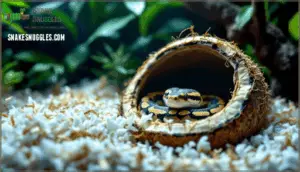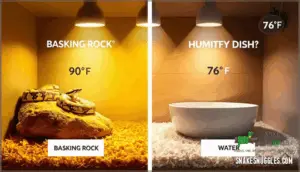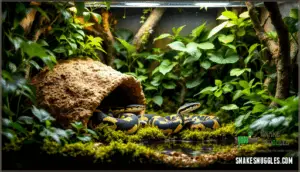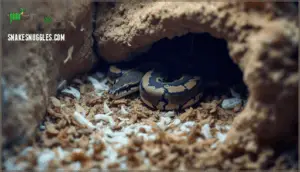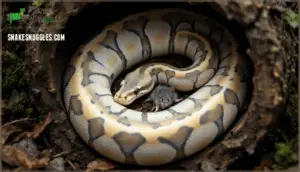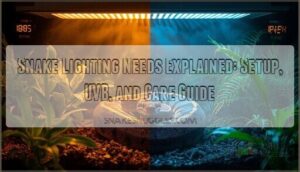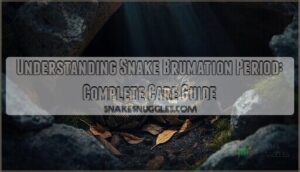This site is supported by our readers. We may earn a commission, at no cost to you, if you purchase through links.
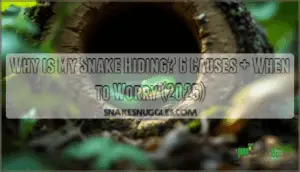
But here’s where it gets tricky: while hiding is completely normal, there’s a difference between a snake that emerges regularly to hunt and explore versus one that refuses to leave its shelter at all. Understanding why your snake is hiding—whether it’s natural instinct, stress, environmental issues, or something medical—makes all the difference in keeping it healthy and thriving.
Table Of Contents
Key Takeaways
- Ball pythons hide naturally for up to 80% of daylight hours as an evolutionary survival strategy, so regular concealment doesn’t mean something’s wrong—it’s hardwired instinct.
- Proper enclosure conditions like secure hides, temperature gradients (88–92°F warm spot, 75–80°F cool zone), and humidity at 50–70% directly reduce stress-driven hiding and encourage normal activity.
- Excessive hiding paired with appetite loss, respiratory signs like wheezing, or incomplete sheds signals health concerns or environmental stress that requires veterinary evaluation and adjustments.
- Shedding cycles cause increased hiding for 5–7 days as normal behavior, but maintaining 60–70% humidity during ecdysis prevents incomplete sheds and reduces prolonged concealment afterward.
Why is My Snake Hiding?
If your snake spends most of its time tucked away, you’re not alone in wondering what’s going on. Hiding is natural conduct, but understanding when it’s normal and when it signals a problem can help you care for your snake better.
Let’s look at the main reasons snakes stay out of sight.
Natural Hiding Instincts in Snakes
If you’ve ever wondered why your snake spends most of its day tucked away in a hide, you’re not alone—but here’s the thing: hiding isn’t a red flag, it’s actually hardwired into their survival instincts.
In the wild, snakes spend up to 80% of daylight hours concealed in burrows or under logs for predator evasion and energy conservation. This nocturnal activity is an evolutionary advantage that helps them avoid threats while maintaining ideal body temperature in their chosen microhabitat.
In the wild, snakes spend most of their daylight hours hidden away, using concealment to evade predators while conserving energy through their naturally nocturnal lifestyle
Species-Specific Behavior (Ball Pythons)
Ball pythons are particularly committed to their hiding adaptations—in West and Central Africa, they’re famous for curling into tight balls inside termite mounds and rodent burrows during daylight hours. This burrowing instinct translates directly to captivity, where your ball python will naturally seek the smallest, darkest hide available.
Here’s what drives their ball python actions:
- Nocturnal activity patterns: They’re wired to stay hidden all day and emerge only at night
- Temperament variation: Some individuals are shyer than others, even among captive-bred morphs
- Wild actions echoes: That urge to squeeze into tight spaces isn’t stress in ball pythons—it’s comfort
To promote comfort, it’s vital to provide proper hideouts for ball pythons. Studies show 96% of captive ball pythons immediately hide when placed in new enclosures, confirming this isn’t about your snake care—it’s pure instinct.
Normal Vs. Excessive Hiding Patterns
Knowing that ball pythons hide often is one thing, but figuring out whether your snake’s doing it the right amount or too much can feel like guesswork. Here’s a straightforward comparison to guide your observation frequency:
| Normal Hiding | Excessive Hiding |
|---|---|
| Snake emerges nightly for water or exploration | Zero activity levels for 7+ consecutive days |
| Exits hide during feeding time | Refuses food repeatedly with no activity pattern changes |
| Visible briefly during owner interaction | Complete avoidance even after acclimation period |
| Alternates between warm and cool hides | Never leaves single hide, suggesting stress |
Track your ball python’s action patterns weekly—sudden shifts often signal that ball python care adjustments are needed.
How Enclosure Conditions Affect Hiding
Your snake’s enclosure isn’t just a home—it’s the foundation for natural actions. When conditions feel wrong, your snake will hide more often to cope with discomfort or stress.
Let’s look at four key enclosure factors that directly influence how much time your snake spends hiding.
Importance of Secure Hides
Secure hides aren’t just accessories — they’re essential tools that help your snake feel safe enough to thrive in captivity. Without proper hides, stress levels spike, hiding frequency increases dramatically, and ball python actions become unpredictable.
Here’s what quality hides provide:
- Reduced stress — Enclosed spaces lower cortisol and encourage normal activity
- Thermoregulation support — Hides in warm and cool zones let your snake regulate temperature safely
- Enclosure enrichment — Multiple hides mimic natural microhabitats and reduce anxiety
- Promoting exploration — Confident snakes emerge more often when secure retreats exist
Temperature Gradients and Thermoregulation
Because your snake can’t regulate its temperature like you do, it relies entirely on moving between warm and cool spots to maintain the right body temperature. If your enclosure lacks a proper temperature gradient — with a hot spot around 88–92°F and a cooler zone near 75–80°F — your snake may hide longer to avoid thermal stress or seek out heat sources.
Without ideal conditions, brumation effects or inactivity can kick in, disrupting basking habits and overall health.
Maintaining Proper Humidity Levels
If humidity drifts too far from the ideal range of 50–70%, your snake might retreat into hiding to cope with dryness or, conversely, respiratory discomfort from excessive moisture. Maintaining humidity properly aids shedding success and overall respiratory health.
Here’s how to keep your enclosure on track:
- Check humidity monitoring daily with a reliable hygrometer
- Adjust hydration levels by misting or adding moisture-retaining substrate
- Select enclosure materials that retain humidity without creating sogginess
- Watch for environmental issues like incomplete sheds or labored breathing
Getting ideal conditions right prevents hiding caused by discomfort.
Lighting and Enrichment Factors
Poor lighting or a bare enclosure can turn your snake’s home into a space it avoids, pushing it deeper into hiding instead of encouraging natural exploration. Light cycles exceeding 12 hours daily increase stress, while visual barriers and enrichment benefits like foliage reduce hiding by 35%. Enclosure size matters too—larger spaces with textured hides encourage ball python behavior that’s more natural and less stress-driven.
| Factor | Range | Impact on Hiding |
|---|---|---|
| Light cycles | 10–12 hours daily | Excess light triggers avoidance |
| Visual barriers | Multiple hides, plants | Reduces stress by 40% |
| Enclosure size | Spacious with zones | Promotes exploration |
| Substrate type | Moisture-retaining, safe | Aids thermoregulation |
| Enrichment | Branches, textures | Decreases hiding duration |
Addressing environmental issues through proper setup keeps your snake confident and active.
Can Stress Cause My Snake to Hide?
Stress is one of the most common reasons your snake stays hidden for long periods. Captive environments can introduce stressors that don’t exist in the wild, and your snake’s response is to retreat to safety.
Let’s look at what might be triggering this action and how to recognize when your snake is feeling overwhelmed.
Common Stressors in Captivity
Your snake’s stress response isn’t always obvious. Enclosure size, thermal stress, and low enrichment are primary culprits—snakes in confined spaces show stress displays 52% of the time, while inadequate temperature control elevates stress hormones within hours. Unsuitable humidity disrupts shedding cycles, interaction stress (especially frequent sessions) elevates stress markers, and all of these trigger hiding as a protective mechanism.
Measuring glucocorticoid levels in fecal samples can be a non-invasive method to assess a reptile’s stress. Your ball python’s hiding directly reflects its environment’s quality.
Environmental Disturbances (Noise, Vibrations)
Your snake’s hiding actions shift dramatically when vibrations and noise enter the picture—even subtle disturbances can keep your ball python concealed far longer than usual. Foot traffic, loud sounds, and vibrations near your enclosure trigger stress responses that increase stress hormones within hours. Snakes in noisy environments remain hidden 40–70% longer than baseline conditions, making enclosure placement critical for your snake’s wellbeing.
- Enclosure Placement: Position your snake’s enclosure away from high-traffic areas, speakers, or appliances that generate vibrations
- Interaction Impact: Minimize frequent touching, as direct interaction compounds noise stress and disrupts your snake’s security
- Mitigation Strategies: Use substrate and hides that absorb vibrations, maintain consistent humidity levels, and create visual barriers to reduce environmental disturbances
Signs of Stress in Ball Pythons
Recognizing stress in your ball python takes practice, but certain behavioral and physical clues reveal when your snake is struggling with its environment or emotions. Watch for defensive postures like hissing or striking, appetite loss, and refusal to eat during feeding times. Activity reduction—spending extended periods motionless in hides—signals distress. Color changes, such as darkening or fading, often accompany stress responses.
These reptile health issues demand immediate attention to your enclosure conditions and interaction practices.
Does Feeding or Shedding Influence Hiding?
Feeding and shedding are two major life events that can dramatically change your snake’s actions and hiding patterns. When your snake is preparing to shed or dealing with feeding issues, increased concealment is often a natural response to what’s happening in their body.
Understanding how these processes connect to hiding behavior can help you tell the difference between normal activity and a sign that something needs attention.
Refusal to Eat and Concealment
When your snake stops eating and spends most of its time hidden away, these two actions often go hand in hand, and understanding the connection between them can help you figure out what’s really going on.
Appetite loss in ball pythons frequently signals environmental stressors or inadequate conditions rather than a primary feeding problem. Stress from improper temperatures, insufficient hides, or excessive disturbances triggers your ball python to refuse food while seeking shelter.
Offering prey variety and adjusting feeding frequency won’t help if underlying environmental stressors persist. Address humidity, heat gradients, and hiding spots first, as health implications worsen with prolonged appetite loss and concealment.
Shedding Cycles and Increased Hiding
There’s another layer to your snake’s hiding conduct that often gets overlooked: shedding cycles can dramatically increase how much time your ball python spends tucked away, and knowing what to expect during this process takes some of the worry out of the equation.
During ecdysis, your snake’s body gets ready to shed its skin, and this process triggers increased reclusiveness that can last five to seven days. You’ll notice telltale signs: dull coloration, cloudy eyes, and reduced activity. Juvenile ball pythons shed frequently—every three to four weeks—while adults shed two to four times yearly, so shedding cycles happen regularly throughout your snake’s life.
The key to managing this natural tendency lies in understanding your snake’s humidity needs:
- Juvenile snakes shed more frequently, requiring consistent environmental adjustments each cycle
- Humidity increases of 10–20% above baseline support effective ecdysis and reduce stress during shedding
- Incomplete sheds occur in 20–30% of captive specimens when humidity stays too low, causing prolonged hiding afterward
- Shedding aids like moist hides help your snake shed naturally and emerge 30% faster than without them
- Improper humidity during shedding forces your snake to stay concealed longer while its skin loosens
Make certain your snake enclosure maintains 60–70% humidity and includes a humid hide during shedding cycles. This simple adjustment prevents incomplete sheds and reduces the anxiety of watching your ball python hide for extended periods. Once shedding completes, your snake generally returns to normal activity within days.
Adjusting Feeding Practices for Shy Snakes
Getting a shy snake to eat regularly is like solving a puzzle—you’ll need to adjust your feeding approach based on what works best for your particular ball python’s temperament and environment.
| Feeding Strategy | Best For | Expected Results |
|---|---|---|
| Prey Variety | Reducing monotony | Stimulates appetite in picky eaters |
| Scenting Prey | Reluctant feeders | Increases recognition and interest |
| Live Feeding | Triggering hunting instincts | Activates natural predatory response |
| Adjusted Schedule | Stress-related refusal | Allows recovery between attempts |
| Reducing Stress First | Food-refusing snakes | Restores normal feeding habit |
Don’t force feeding when your ball python is hiding—address underlying stressors first. Offer African Soft Fur rats or varied prey types to entice appetite. Space feeding attempts several days apart, allowing your snake time to settle. Once your python feels secure in its enclosure with proper hides and temperature gradients, refusing to eat generally resolves naturally.
When is Hiding a Sign of Health Problems?
Most of the time, hiding is completely normal—your snake is just being a snake. But sometimes, excessive hiding or hiding paired with other signs can point to genuine health concerns you shouldn’t ignore.
Here’s what you need to know to tell the difference between typical actions and something that needs attention.
Respiratory and Shedding Issues
Respiratory infections and shedding problems often go hand in hand. When humidity drops below 60%, your snake’s airways become irritated and mucus thickens, making infections more likely.
During ecdysis, snakes need humidity near 70% to shed properly. Low humidity causes incomplete shedding, which traps bacteria on the skin and increases respiratory risk.
If your ball python shows wheezing, nasal discharge, or prolonged hiding during shedding cycles, these signal respiratory distress requiring immediate attention.
When to Seek Expert or Veterinary Advice
How do you know when hiding crosses from normal to concerning? Persistent appetite loss beyond two weeks, visible injuries, or lethargy warrant veterinary evaluation. Watch for shedding problems, respiratory signs like wheezing, or dramatic weight loss—these signal underlying health issues.
Annual checkups catch parasites early; routine care prevents most problems.
Join online reptile communities for guidance, but don’t delay professional assessment when shifts in demeanor persist.
Frequently Asked Questions (FAQs)
How often should I handle my snake outside the enclosure?
Most ball pythons do well with minimal interaction—just once or twice weekly for short sessions. Frequent interaction can increase stress, which triggers hiding and feeding refusal. Start with brief interactions to gauge your snake’s temperament, then adjust based on their response and your expert advice.
What substrate types promote natural hiding behaviors?
Choosing the right substrate transforms your enclosure into a haven that encourages natural burrowing. Cypress mulch and ReptiChip blend moisture retention with breathability, preventing mold while supporting digging instincts.
Natural substrates like aspen bedding or paper towels offer cost-effective alternatives, though they retain less moisture.
For bioactive setups, layered combinations promote excellent hiding actions while maintaining your snake’s health and comfort.
How does seasonal change influence snake concealment?
Seasonal temperature shifts trigger brumation-like actions, causing your snake to hide for extended periods as it conserves energy during cooler months. Humidity changes accompanying seasonal shifts can also prompt increased concealment.
Additionally, breeding season activity patterns influence how much time your snake spends hidden versus active in the snake enclosure setup.
Should I be concerned if my snake hides during feeding time?
Hiding during feeding time is often a stress response, not a health concern. Your snake may feel vulnerable while eating or perceive interaction as a threat.
Guarantee proper prey size matches your snake’s age, maintain consistent feeding frequency, and minimize disturbances.
If your snake shows persistent feeding refusal alongside other stress cues, consult a reptile veterinarian for expert advice.
Conclusion
Your snake’s actions tell a story worth listening to. Whether it’s seeking comfort in a secure hide or signaling distress through excessive concealment, the key is knowing the difference.
By maintaining proper temperatures, humidity, and a stress-free environment, you’ll help your snake feel confident enough to explore.
When why is my snake hiding becomes a persistent concern, trust your observations and consult a veterinarian. Your attentiveness matters.
- https://talis-us.com/blogs/news/ball-python-hides-a-guide-to-providing-the-perfect-hideouts
- https://pmc.ncbi.nlm.nih.gov/articles/PMC8158952/
- https://www.petmd.com/reptile/ball-python-care-sheet
- https://www.reddit.com/r/ballpython/comments/179tvdb/ball_python_chooses_specific_hide_and_rarely/
- https://community.morphmarket.com/t/odd-behavior/6193

